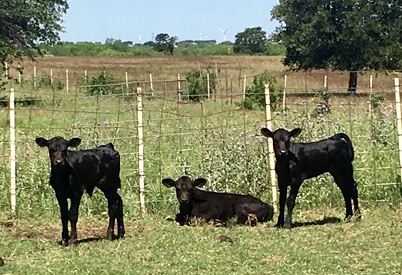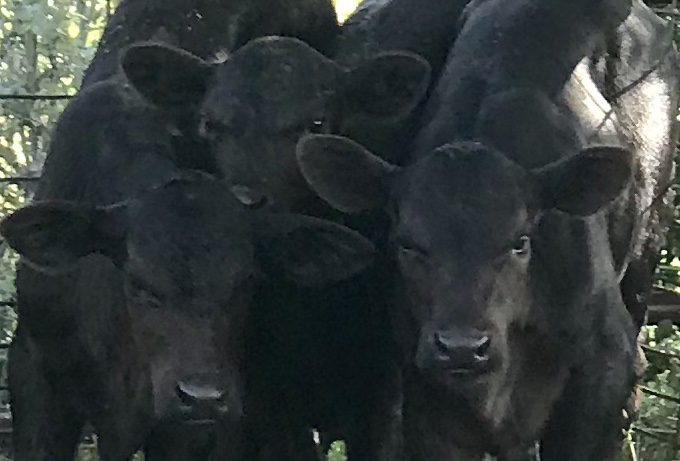Farm & Ranch
Heifer gives birth to triplets in Young County


A heifer from North Texas recently defied the odds when she delivered not one, not two, but three calves earlier this month, an occurrence that happens in only one out of every 100,000 births.
The first-time mom and her triplets, two bulls and one heifer, are reported to be thriving by their owners, Sam Gleaves and his wife, Linda. The pair, along with Christella Jones, run Jones Ranch, located in the small rural community of Farmer, Texas, just 10 miles from Loving in Young County. The ranch contains more than 1,000 acres with 130 cow-calf pairs.
The black Angus heifer is around the age of three and was bred with a half Corriente bull. When she went into labor, the timing just happened to be perfect as Gleaves was just stopping by to check on her and the other cattle.
“The delivery went really good. I just happened to be over there, I try to check them every day, and thought she had twins because there were no other heifers around. We had two sets of twins then already. I didn’t bother her, she was taking care of them,” recalled Gleaves.
The rancher left his new mom alone and returned around 30 minutes later and received the shock of his life when there was a third baby on the ground.
“I thought this can’t be right,” chuckled Gleaves. “But there were four other heifers left and they weren’t even showing they were going to have calves yet, probably only four or five months, no bags or anything. They had to be hers. My wife looked up how rare it is, and it’s unbelievable it happened.”
It would be understandable for a first-time mother of three to be overwhelmed, but so far the triplets are being well taken care of and seem to be flourishing.
“She is a great mother, she takes care of all three of them,” explained the rancher.
To Gleaves’ surprise, the mother had a bit of help from the other cattle shortly giving birth.
“What is funny is when she had that third one, the other four heifers came over and started helping her clean them up. It is like they are sisters or something, they knew she was busy and I’ll be darn if they didn’t come over there. I thought that was really something they helped her out,” said Gleaves.
It was one of the more surprising moments of his ranching career, which started around 18 years ago. The couple first trained horses in Colleyville, when Gleaves’ father-in-law, Bob Jones, offered him a job in the electrical business. Eventually, his in laws bought the Jones Ranch.
“Linda and I decided no one else in the family really wanted to take over the ranch, so when the electrical business sold we moved up here around 18 years ago. It was 500 acres, and no one wanted to mess with cows, so we did and since then the ranch has grown to 1,000 acres with 130 cow calf pairs,” said Gleaves.
His father-in-law has since passed, but Christella Jones, his 86-year-old mother-in-law, lives on the ranch. Born in Farmer with her five sisters, she returns to the roots where she was born.
It is around Jones’ house where the triplets now live, playing and growing under the direction of their mom and two older cows as the ranchers keep an eye on coyotes and any other dangers that might present themselves.
Farm & Ranch
Acorn Toxicity

By Barry Whitworth, DVM, MPH
With the prolonged drought, most pastures in Oklahoma end up in poor condition. With the lack of available forage, animals may go in search of alternative foods.
If oak trees are in the pastures, acorns may be a favorite meal for some livestock in the fall. This may result in oak poisoning.
Oak leaves, twigs, buds, and acorns may be toxic to some animals when consumed.
To read more, pick up a copy of the November edition of North Texas Farm & Ranch magazine, available digitally and in print. To subscribe by mail, call 940-872-5922.

Farm & Ranch
Silver Bluestems

By: Tony Dean
There are a handful of grasses on North Texas grazing lands ranchers need to know, not because they are highly desirable, but rather because they are not of much value. I call them “decom” plants, which is am acronym for “Don’t Ever Count On Me.” Silver bluestem is a “decom” grass.
Silver bluestem is a perennial which grows in all areas of Texas. It can survive in almost all soil types, and in full sun conditions or in semi shade. It grows up to three feet tall and is easily recognized with the presence of the white fuzzy seed head. Also, one of the identifying characteristics of Silver bluestem is a bend in the stems at each node, causing the plants to take on a rounded shape as they mature.
To read more, pick up a copy of the November edition of North Texas Farm & Ranch magazine, available digitally and in print. To subscribe by mail, call 940-872-5922.

Farm & Ranch
Meanwhile Back At The Ranch

By: Rayford Pullen
Fall is here which means winter is closing in on us and before we officially get into winter, we need to make sure our factories are either producing or will be producing in a few months.
We have been pregnancy testing our cows this fall and if they are not bred or nursing a calf, we are bidding them adios. With annual costs somewhere between $900.00 and $1,000.00 per cow, those cows not producing a live weaned calf are costing us quite a bit.
To read more, pick up a copy of the November edition of North Texas Farm & Ranch magazine, available digitally and in print. To subscribe by mail, call 940-872-5922.
-

 Country Lifestyles2 years ago
Country Lifestyles2 years agoScott & Stacey Schumacher: A Growth Mindset
-

 Country Lifestyles8 years ago
Country Lifestyles8 years agoStyle Your Profile – What your style cowboy hat says about you and new trends in 2017
-

 HOME8 years ago
HOME8 years agoGrazing North Texas – Wilman Lovegrass
-

 Equine1 year ago
Equine1 year agoThe Will to Win
-

 Country Lifestyles5 years ago
Country Lifestyles5 years agoAmber Crawford, Breakaway Roper
-

 Outdoor9 years ago
Outdoor9 years agoButtercup or Primrose?
-

 Country Lifestyles8 years ago
Country Lifestyles8 years agoJune 2016 Profile – The man behind the mic: Bob Tallman
-

 Country Lifestyles8 years ago
Country Lifestyles8 years agoDecember 2016 Profile, Rusty Riddle – The Riddle Way




